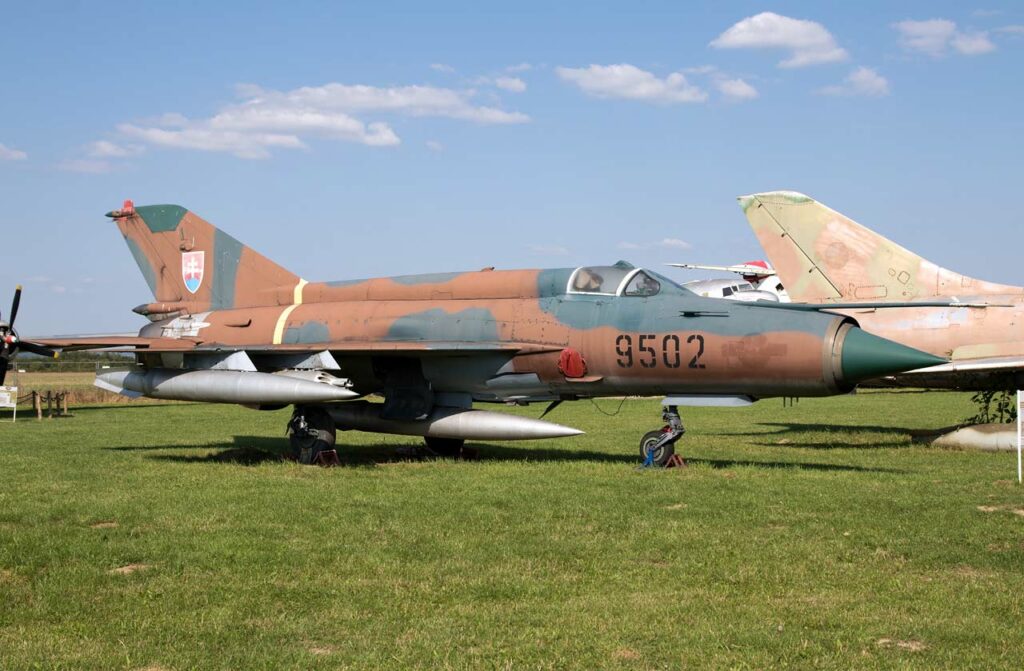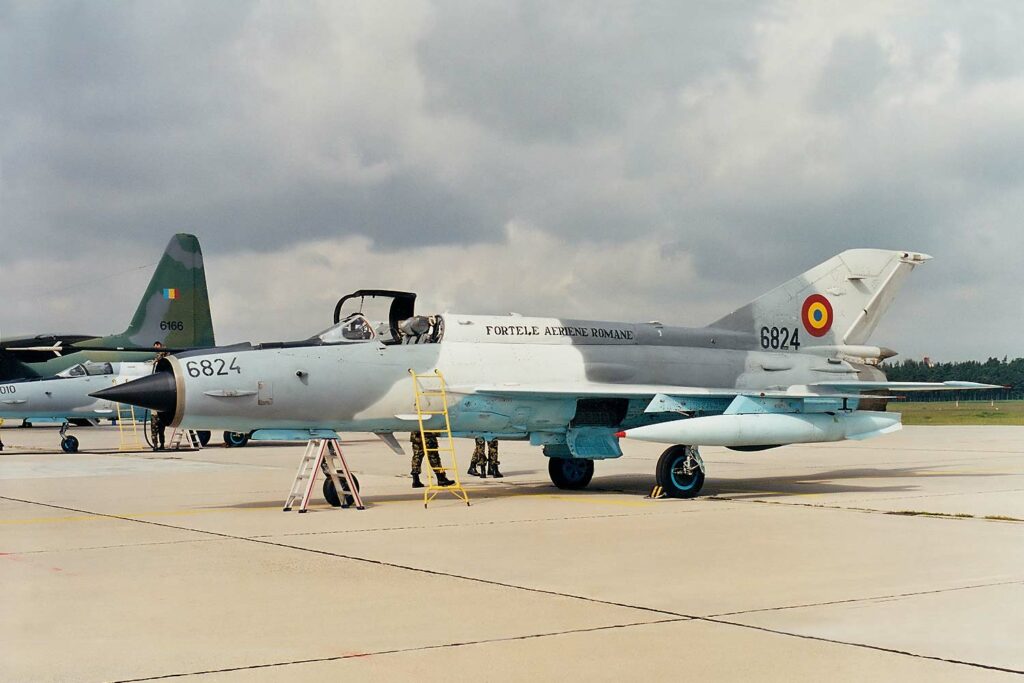Iconic Soviet supersonic jet fighter, the MiG-21 Fishbed features delta wings, Mach 2 capabilities, and a single-engine design for air combat superiority.
In brief
The Mikoyan-Gurevich MiG-21, known by its NATO reporting name “Fishbed,” is a supersonic jet fighter aircraft developed in the Soviet Union. Its design emphasizes a blend of speed, agility, and simplicity, making it one of the most produced jet fighters in aviation history. The MiG-21 features a delta wing configuration, a single-engine layout powered by a Tumansky R-25 turbojet, and a top speed of over Mach 2. Capable of both air-to-air combat and ground attack missions, it was equipped with a variety of weaponry including cannons, missiles, and bombs. First flown in 1956, it entered service in 1959 and has seen widespread use across over 60 countries, making it a staple in many air forces during the Cold War era.

History of the Development of the Mikoyan-Gurevich MiG-21 (Fishbed)
The development of the Mikoyan-Gurevich MiG-21 began in the early 1950s, against the backdrop of a rapidly evolving aviation industry post-World War II. The advent of jet propulsion and the onset of the Cold War necessitated advancements in military aircraft to ensure superiority in potential aerial combat scenarios. The Soviet Union, keen on establishing a formidable air force, sought to develop a supersonic fighter that could outperform contemporary Western aircraft.
Launched by the Mikoyan Design Bureau, led by Artem Mikoyan and Mikhail Gurevich, the development program aimed to create a versatile, highly capable fighter jet. The MiG-21’s design was revolutionary for its time, featuring a delta wing configuration which offered an optimal balance between speed, maneuverability, and range.
The MiG-21 made its maiden flight on February 14, 1955, marking a significant milestone in Soviet aviation. Its introduction into service in 1959 represented a leap forward in jet fighter technology. The NATO codename “Fishbed” was assigned as part of a naming convention for Soviet aircraft, though the reasons behind specific names often remain unexplained.
The aircraft was developed during a period when air combat theory was rapidly changing. Initially focused on high-speed, high-altitude engagements, the design philosophy of fighter aircraft evolved to emphasize versatility and all-weather capabilities. The MiG-21 reflected these changes, embodying a design that was adaptable to various roles, from interception to ground attack.
Design of the Mikoyan-Gurevich MiG-21 (Fishbed)
The MiG-21’s design is characterized by its delta wing configuration, which was chosen for its aerodynamic efficiency at high speeds and altitudes. This design allowed the aircraft to achieve a top speed of over Mach 2 (approximately 1,385 mph or 2,230 km/h) and a service ceiling of around 59,000 feet (18,000 meters). The aircraft’s length is approximately 57 feet (17.4 meters), with a wingspan of 23.5 feet (7.15 meters). Its lightweight construction, primarily using aluminum alloys, contributed to a maximum takeoff weight of approximately 20,000 pounds (9,000 kilograms).
The delta wing, while advantageous for speed and altitude, presented challenges in terms of maneuverability and landing speeds. To mitigate these, the MiG-21 was equipped with a unique boundary layer control system that blew high-pressure air over the wings during takeoff and landing, improving lift.
The aircraft was powered by a single Tumansky R-25 turbojet engine, which provided a thrust-to-weight ratio that was competitive for its time, contributing to its impressive acceleration and climb rate. The MiG-21’s design also included a radar system for targeting and navigation, though it was considered basic compared to Western counterparts.
Performance of the Mikoyan-Gurevich MiG-21 (Fishbed)
The MiG-21’s performance metrics are a testament to its design and engineering. Its single Tumansky R-25 engine, capable of producing up to 15,650 pounds of thrust with afterburner, enabled the aircraft to reach speeds exceeding Mach 2. The aircraft’s operational range was approximately 1,200 miles (1,931 kilometers) with external fuel tanks, allowing for significant strategic flexibility.
In comparison to its contemporaries, such as the American F-4 Phantom II, the MiG-21 was lighter and more agile, allowing it to excel in close-range dogfights. However, its shorter range and simpler avionics placed it at a disadvantage in beyond-visual-range engagements.
Variants of the Mikoyan-Gurevich MiG-21 (Fishbed)
The MiG-21’s production run saw the development of numerous variants, each designed to enhance certain aspects of its performance, capabilities, or to adapt to specific roles. These include the MiG-21F interceptor, the MiG-21PF with improved radar and avionics, and the MiG-21bis, which featured an upgraded engine and enhanced weapons systems. Each variant represented iterative improvements over its predecessors, showcasing the platform’s adaptability and the Soviet Union’s commitment to maintaining its competitiveness.

Military Use and Combat of the Mikoyan-Gurevich MiG-21 (Fishbed)
The MiG-21’s combat history is extensive, having been used in numerous conflicts across the globe. It was a key player during the Vietnam War, where it engaged U.S. aircraft in numerous dogfights. The MiG-21 proved to be a formidable adversary, leveraging its speed and agility to counter the more heavily armed but less maneuverable American fighters. Its armament typically included a mix of air-to-air missiles, a 23mm or 30mm cannon, and the ability to carry bombs for ground-attack missions.
The aircraft saw service in the Middle East, participating in the Arab-Israeli conflicts, where it faced off against Israeli Mirage III and F-4 Phantom II fighters. Despite its successes, the MiG-21 also suffered losses, highlighting the importance of pilot training and tactics in aerial combat.
The MiG-21 was widely exported, serving in the air forces of over 60 countries. Its affordability and performance made it a popular choice for nations seeking to bolster their air defense capabilities. Today, while many air forces have retired the MiG-21 in favor of more modern aircraft, it remains in service in several countries, a testament to its enduring legacy.
The Mikoyan-Gurevich MiG-21 Fishbed stands as a monumental figure in military aviation history. Its design and performance characteristics, from its delta wings to its Mach 2 speed, represent a significant period of innovation and development in fighter aircraft technology. Despite its limitations, the MiG-21’s versatility, ease of maintenance, and combat efficacy ensured its widespread use and lasting impact on air combat doctrine and strategy.
Back to the Fighter Jet section.